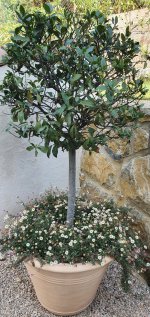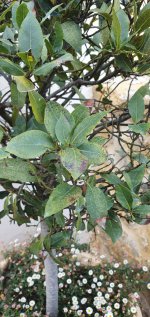Oh, how we can learn from these forums. I live opposite a small park, and directly across the road is a stand of several Laurus nobilis, (Bay trees). The birds gorge themselves on the fruits, and eventually the seeds are plentifully deposited in neighbouring gardens. What with them and the winged seeds of the Sycamores and various Acers our gardens can, if neglected, soon become tree nurseries.
I have often potted up bay seedlings. They are pretty fast growers, so that by the end of their first season, you can easily have a plant of some twelve inches high. I have often noticed the odd leaf having the infected evidence. I admit. Little note is made of this. Naughty plant pathologist. Material on your doorstep, etc. Perhaps one day, a sample will find it's way to my microscope.
In the meantime. We so often resort to chemical sprays etc, when our plants show signs of attack. These sprays/treatments do not provide a cure. A diseased leaf/twig will remain such until it is removed, naturally or by your hand. The point of burning. Here I refer to the burning of rose leaves etc blighted by Black-Spot. Many bacterial attacks/infections, will stay on it's victim long after even athe fall and end of season. The bacteria can survive in the soil and the dying leaves etc. So the very wise advice is to burn. So the benefits of spraying. Here you basically cover/coat the surface of the plant,s structure so as to form a barrier against such invasions. Hope this is of some use.





